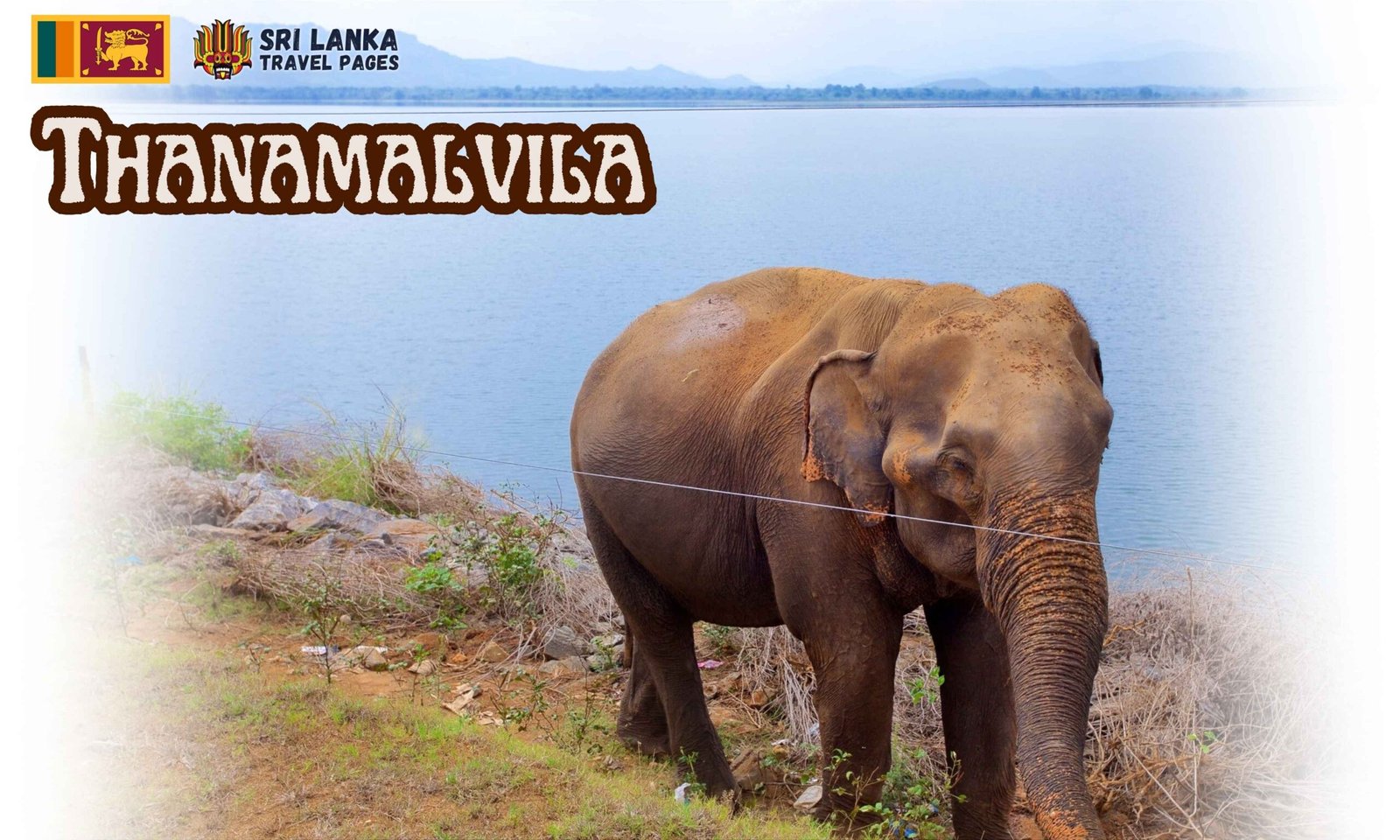
スリランカのウバ州モナラガラ地区に位置する タナマルビラ タナマルヴィラは、旅行者に静かな田舎暮らしの隠れ家を提供する隠れた宝石のような場所です。緑豊かな水田、サトウキビ畑、そして森林に囲まれたタナマルヴィラは、大都市の喧騒を離れて静寂を求める人々にとって理想的な場所です。主要な農業地域であるタナマルヴィラは、農業と灌漑で栄えており、キリンディ・オヤ川は地元の生活を支える上で重要な役割を果たしています。ウェラワヤ・エンビリピティヤ道路沿いという戦略的な立地は、近くの国立公園を訪れる観光客にとっても便利な拠点となっています。 ヤラ, ウダワラウェ、 と ルヌガンヴェヘラ.
タナマルヴィラを真に特別なものにしているのは、その素朴な村の魅力と、手つかずの自然美です。この地域はバードウォッチング、写真撮影、そして文化体験に最適です。スリランカの伝統的なおもてなしを体験したり、美しい遊歩道を散策したり、地元の農業体験に参加したりすることもできます。この町の精神的な側面は、古代の寺院や地域の祭りに反映されており、この地域に深く根付いた伝統を垣間見ることができます。
ウバ州での野生動物ツアー、ロードトリップ、文化探訪など、 タナマルビラ シンプルさと自然が爽やかに融合した、スリランカの魅力あふれる場所です。エコツーリスト、バックパッカー、そしてスリランカの真の姿を探究したい地元の冒険家にとって理想的な目的地です。南東部の中心地を訪れる予定の方は、タナマルヴィラをぜひ旅程に加えてください。ここは、心温まる体験をする価値のある場所です。
総人口
30,200
GNディビジョン
14
🌾 スリランカのタナマルビラが特別な理由とは?
自然、文化、コミュニティが共存する場所
スリランカのモナラガラ地区の南部の中心部に位置する タナマルビラ 乾燥地帯の荒々しい魅力と、田舎暮らしの心温まるリズムが見事に融合する、過小評価されている宝石のような町です。曲がりくねったキリンディ・オヤ川に縁取られたこの静かな町は、ウダワラウェとウェラワヤの単なる中継地ではありません。農業、生物多様性、そして伝統が調和とバランスのとれた生活を生み出すコミュニティなのです。
🐘 野生との出会いと美しいトレイルへの入り口
タナマルヴィラは自然愛好家にとって夢のような場所です。 ルヌガンヴェヘラ国立公園 そして手の届く範囲に ウダワラウェ国立公園野生動物サファリの拠点として最適です。町の水田のすぐ向こうには、ゾウ、シカ、そして珍しい鳥たちが生息しています。豊かな生物多様性、淡水の小川、そして乾燥地帯の森林遊歩道は、エコツーリズムやバードウォッチングの拠点としても人気です。
🌾 誇り高き農業の中心地
タナマルヴィラの隅々まで農業が息づいています。広大なサトウキビ畑からバナナ農園、伝統的な水田まで、農業は経済と文化の両方を支えています。 アルトゥ・サハル・マンガラヤ (新米祭り)は敬意を持って執り行われ、地域社会が集まって大地の恵みを祝います。
🛕 あらゆる場所に文化の知恵が息づく
タナマルヴィラは壮大なモニュメントで飾られていないが、 村の神社, 菩提樹、 と 儀式的な慣習 代々受け継がれてきた伝統。長老たちは月明かりの下で古来の慣習や田舎の物語を語り、質素さと深く根付いた信仰が融合した生活様式を守っています。
🍲 乾燥地帯の本物の味
ここでは、すべての食事がスリランカの乾燥地帯の本物の味です。 クラッカンピット, 新鮮な川魚のカレー、 と ゴーヤのサンボル 日々の必需品です。地元産のジャガリー、新鮮なハーブ、そして伝統的なココナッツベースのレシピは、訪れる人々にこの島の素朴な食文化の魂を垣間見せてくれます。
🤝 あなたを受け入れるコミュニティ
タナマルヴィラの温かさは、そこに住む人々の中に息づいています。一人旅でも、ボランティアでも、探検家でも、笑顔で迎えられ、共に食事をし、地元の人々の暮らしにまつわる話を聞くことができます。村の教師や職人から、プログラミングと農業を隣り合わせで学ぶ小学生まで、この町は粘り強さと寛大さの精神に満ち溢れています。
🌱 より緑豊かな明日へ
今日、タナマルヴィラはゆっくりと 持続可能な農村の中心地新たな取り組みが生まれ、 エコ農業, コミュニティ教育、 と 若者のリーダーシップ生物多様性ホットスポット間の戦略的な立地と土地管理の伝統により、環境保護、スローツーリズム、社会的影響に関心のある人々にとって有望な場所です。
タナマルヴィラはただ通り過ぎる場所ではなく、立ち止まり、呼吸し、つながる場所です。 自然の美しさ、文化の奥深さ、または有意義なコミュニティ体験を求める人でも、タナマルビラはあなたを温かく迎え、発見されるのを待っている物語を提供します。
| Nコード | 英語名 |
|---|---|
| 005 | カンディヤピタウェワ |
| 010 | コタウェヘラマンカダ |
| 015 | アルトゥウェワ |
| 020 | ハンベガムワ |
| 025 | ハンベガムワコロニー |
| 030 | カハクルラン・ペレッサ |
| 035 | マハウェワ |
| 040 | スリヤ・アラ |
| 045 | ウスガラ |
| 050 | ニカウェワ |
| 055 | ボダガマ |
| 060 | キヴル・アラ |
| 065 | シッタラマ |
| 070 | シエヌックワ |
| 年 | 推定人口 |
|---|---|
| 2012 | 26,683人(実際の国勢調査) |
| 2015 | ≈ 27,700 |
| 2020 | ≈ 29,500 |
| 2024 | ≈ 30,200 |
- 警察署:047-2234022 / 071-8591549
☀️ タナマルビラを訪れるのに最適な時期
スリランカのウバ州に位置するタナマルビラは、一年を通して熱帯乾燥地帯の気候です。一年を通してアクセス可能ですが、訪れるのに最適な時期を把握しておくことで、自然、野生動物、そして地域社会の生活を存分に楽しむことができます。
📅 12月から3月 – 理想的な時期
からの期間 12月から3月まで タナマルヴィラを訪れるのに最も快適な時期です。乾燥していて晴れた天気で、近くの観光スポットを散策するのに最適です。 ウダワラウェ国立公園 と ルヌガンヴェヘラ貯水池野生動物が頻繁に見られ、道路の状態も良好で、空も澄んでいるので、自然写真やエコ旅行に最適です。
🌧️ 5月から9月 – グリーンシーズン
この時期は時折雨が降り、湿気の多い日もありますが、景色は緑豊かな楽園へと変貌します。オフシーズンの旅行を好む方には最適で、人混みも少なく、料金も手頃な静かな時期です。特に早朝と夕方は景色が素晴らしいです。
⚠️ 10月から11月 – モンスーン注意
北東モンスーンの影響で大雨が降るため、10月と11月は観光には最も適さない時期です。道路はぬかるみ、野生動物の観察も制限される可能性があります。旅行は可能ですが、不要不急の旅行はお勧めしません。
🗓️ 概要表
| 季節 | 天気 | 活動 | 最適な用途 |
|---|---|---|---|
| 12月~3月 | 乾燥して晴れ | サファリ、村のツアー、バードウォッチング | 自然愛好家、写真家 |
| 5月~9月 | 湿気と緑 | 景色、オフシーズンの訪問 | 低予算旅行者、エコツーリスト |
| 10月~11月 | 大雨 | 屋外活動の制限 | 可能であれば避ける |
✨ 象を追跡したり、農地の霧のかかった日の出を楽しんだり、静かな田舎の環境でただリラックスしたり、 タナマルヴィラは12月から3月にかけてがベストシーズンです — 自然が完璧なバランスを保っているとき。
🛏️ タナマルヴィラの宿泊施設を検索
📍 タナマルビラの地理的概要
タナマルヴィラはスリランカの南東部に位置し、 モナラーガラ地区 の ウバ州島の乾燥地帯の中心部に位置するこの地域は、平坦な平原、起伏のある乾燥林、貯水池灌漑システム、そして緑豊かな農地が特徴です。海抜は適度な高さで、周囲の肥沃な低地は、 キリンディオヤ川農業にとって重要な水源です。
タナマルヴィラは、いくつかの重要な町やランドマークに囲まれています。 ウダワラウェ 南西に、 ウェラワヤタウン 北に、そして カタラガマ さらに南へ。A18号線(ウェラワヤ-エンビリピティヤ)沿いの中心部に位置しているため、南海岸とスリランカ内陸部の国立公園を旅する人々にとって重要な交通路となっています。
気候は熱帯乾燥気候に分類され、乾期と雨期がはっきりしているため、サトウキビ、バナナ、トウモロコシ、水田などの作物に最適です。この地域の自然景観には、岩場、草原、人工池、乾燥林などがあり、重要な生物多様性地域となっています。 ルヌガンヴェヘラ国立公園.
全体的に、タナマルビラの地理は、農村農業、生態系の豊かさ、戦略的重要性が調和して融合しており、コミュニティ、文化、保護が自然に共存する風景となっています。
🌾 タナマルヴィラの地域経済と農業
の鼓動 タナマルビラの地域経済 広大で肥沃な農業地帯に恵まれています。スリランカの乾燥地帯に位置し、 キリンディオヤ川この地域は、多様な作物や畜産業に適しています。農業は食料を供給するだけでなく、人々の生活、地域社会の伝統、そして地元の市場を支えています。
主な経済活動としては、 水田耕作, サトウキビ栽培、 と バナナ農園畑は古代の貯水池システムと現代の運河網によって灌漑されています。さらに、トウモロコシ、キャッサバ、パパイヤ、ココナッツ、野菜などの作物は、季節的な雨水と河川から供給される貯水池からの補助水に依存する小規模農家によって広く栽培されています。
畜産、特に牛、水牛、ヤギの飼育は、乳生産と耕作の両面で重要な役割を果たしています。多くの世帯が裏庭で養鶏や家庭菜園を行っており、食料安全保障と収入創出にさらに貢献しています。
地元の市場や「ポーラ毎週「マーケット」が開催され、農家や商人が新鮮な農産物、スパイス、乳製品、手作り品などを販売します。これらの市場は農村経済を支えるだけでなく、社会的なつながりや文化交流を促進します。
持続可能な農業の実践と若者主導の農業プロジェクトの台頭により、タナマルビラは深く根付いた農業の伝統を守りながら革新を取り入れており、スリランカのウバ州における農村の回復力と経済的自立のモデルとなっています。
👨👩👧 タナマルヴィラのコミュニティと文化
人生 タナマルビラ タナマルヴィラは、コミュニティの価値観、古くからの慣習、そして田舎ならではの温かいおもてなしに深く根ざしています。住民のほとんどが農業や小規模産業に従事し、協力、伝統、そして共に歩む進歩によって栄えています。タナマルヴィラの住民は、温かさ、粘り強さ、そして仕事と地域社会への献身で知られています。
村の文化は農業暦と密接に結びついており、季節ごとの祭りには次のようなものがあります。 アルト・サハル・マンガリヤヤ 新米祭りは、収穫への感謝を捧げる祭りです。伝統的な儀式、詠唱、寺院への供え物は、地元の生活に深く根付いた仏教の精神性と影響力を反映しています。
タナマルヴィラには、静謐な寺院や神聖な菩提樹が点在し、宗教行事、瞑想、満月(ポヤ)の儀式のために人々が集います。これらの精神的な空間は、家族や隣人同士の結束を強める社交の中心地としても機能しています。
物語、民謡、田舎の遊びは、今でも日常生活の一部であり、特に年長者たちは若い世代に知恵を伝えています。コミュニティセンターや学校は、村の集会や祝賀行事、若者主導の活動の場として利用されることも少なくありません。
訪問者であれボランティアであれ、タナマルヴィラの文化は見せ物ではなく、生き方そのものであることに気づくでしょう。訪問者はしばしば家に招かれ、新鮮な果物を振る舞われ、まるで家族のように扱われ、あらゆる交流が本物で忘れられないものになります。
🏫 タナマルヴィラの教育と公共施設
タナマルヴィラには、住民の日常生活を支える公共サービスと教育機関のネットワークが充実しています。農村部でありながら着実に発展を続けるタナマルヴィラは、学校、医療、交通機関、そして地域社会サービスといった、住民の幸福と長期的な成長を支える不可欠な施設の提供に重点を置いています。
🎓 学校と教育
町には公立の小学校と中学校が混在しており、その中には次のような人気校も含まれています。 タナマルヴィラ・マハ・ヴィディヤラヤ と シヤンバラゴダ・ヴィディヤラヤこれらの学校は、周辺の村々の子供たちの学習拠点として機能しています。科学、数学、IT、農業、シンハラ語などの科目が国家カリキュラムに基づいて教えられています。
近年、学校を卒業した若者に農業、大工仕事、裁縫、ITといった実践的なスキルを身につけさせるため、職業訓練センターや非公式教育プログラムが数多く導入されています。これらのプログラムは、農村部の若者育成を目的としたNGOや地方自治体のプロジェクトによって支援されることが多くなっています。
🏥 健康と安全のための施設
の タナマルビラ地区病院 外来診療、母子ケア、救急サービスを含むプライマリヘルスケアサービスを提供しています。法執行機関と公共の安全のために、 タナマルヴィラ警察署 町内を中心的に活動し、民事問題と道路安全施行の両方をサポートします。
📚 図書館と公共サービス
公共図書館と複数のコミュニティセンターが、子供や若者の学習と読書を支援しています。地域の地方事務局は、土地登記、出生証明書、農業支援プログラム、災害救援調整などの行政サービスを提供しています。
🚍 交通と接続
タナマルヴィラは、ウェラワヤ、エンビリピティヤ、ウダワラウェといった近隣の町と定期バス路線で結ばれています。整備された道路とトゥクトゥクのサービスにより、農村部の住民は学校、診療所、市場などへ簡単にアクセスできます。
全体的に、タナマルヴィラの教育および公共サービスのインフラは着実に進化しており、スリランカのモナラガラ地区における重要な農村中心地としての役割を強化しています。
🚌 タナマルヴィラの交通とアクセシビリティ
タナマルヴィラはスリランカ南部の乾燥地帯に位置し、中央丘陵地帯と南部沿岸の町々を結ぶ重要な交通拠点となっています。田園地帯に位置しながらも、道路網は比較的整備されており、公共交通機関と自家用交通機関の両方を利用できます。
🛣️ 道路の接続性
タナマルヴィラを通る主要道路は A18高速道路、リンク ウェラワヤタウン に エンビリピティヤこの道路は、次のような主要都市に直接アクセスできます。 ウダワラウェ, カタラガマ、 と ハンバントタ道路は概ね良好な状態であり、一年を通して乗用車、バン、バスの通行に適しています。
🚍 公共交通機関
スリランカ運輸局(SLTB)と民間のバス会社が運行する定期バスがタナマルヴィラを走っています。バスは町と以下の都市を結んでいます。 モナラーガラ, コロンボ, バドゥーラ、その他の地域の中心都市へも簡単にアクセスできます。町には小さなバスターミナルといくつかの道路沿いの停留所があります。
🛺 ローカルモビリティ
町内や近隣の村内の短距離の場合は、 三輪車(トゥクトゥク) 最も一般的で手頃な交通手段です。バイクや自転車も地元の人々、特に農家や小学生に広く利用されています。
🗺️ 観光スポットへのアクセス
タナマルヴィラは、近くの観光地へのアクセスに理想的な場所にあります。 ウダワラウェ国立公園 (約35分) ルヌガンヴェヘラ国立公園 (15分) ウェラワヤタウン (30~40分)。この地域の多くのエコロッジやホームステイでは、訪問者向けの交通手段を手配しています。
🚗 自家用車でのアクセス
自家用車で旅行される方は、ガソリンスタンド、市場近くの駐車場、そしてよく整備された道路標識を見つけることができます。GPSナビゲーションも良好で、雨季でも道路状況は良好です。
要約すると、タナマルビラは田舎町かもしれませんが、道路のアクセスと交通手段の選択肢が豊富なため、地元の人々やスリランカ南部を観光する旅行者にとって便利な立ち寄り先となっています。
タナマルヴィラへの行き方
スリランカのウバ州モナラガラ県に位置するタナマルヴィラは、いくつかの主要な町や都市からアクセス可能です。コロンボ、ウェラワヤ、ウダワラウェのいずれの地域からでも、タナマルヴィラへ続く道からは、乾燥地帯の森林、農地、そして川の美しい景色をお楽しみいただけます。以下の表で最適なルートとGoogleマップのリアルタイムルートをご確認ください。
| 市 | 距離 | 推定所要時間 | ルート情報 |
|---|---|---|---|
| コロンボ | 235キロ | 6~7時間 | |
| モナラーガラ | 33キロ | 45分 | |
| ウェラワヤタウン | 40キロ | 1時間 | |
| ウダワラウェ | 22キロ | 30分 |
📍 インタラクティブルートマップ
🌿 タナマルビラを訪れる、または投資する理由
タナマルビラ スリランカの乾燥地帯の荒野への玄関口として際立っており、エコアドベンチャー、文化遺産、持続可能な農業が融合した、観光と農村開発の両方にとって将来性に富んだ場所です。
- 🐘 自然との近さ: ウダワラウェ国立公園とルヌガンヴェヘラ国立公園に近く、サファリやエコツーリズムに最適です。
- 🌾 繁栄する農業: サトウキビ、バナナ、水田が地元経済の基盤を形成しています。
- 🔧 農村イノベーション: 若者主導の研修プログラム、協同農業、農業起業が増加しています。
伝統、自然、そしてチャンスが隣り合って育つタナマルビラを探索しましょう。
